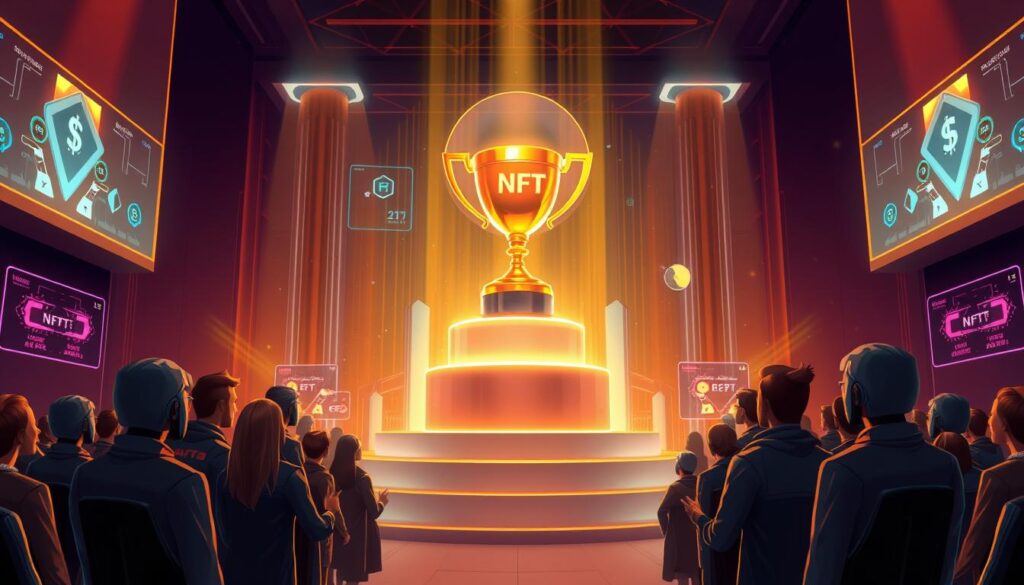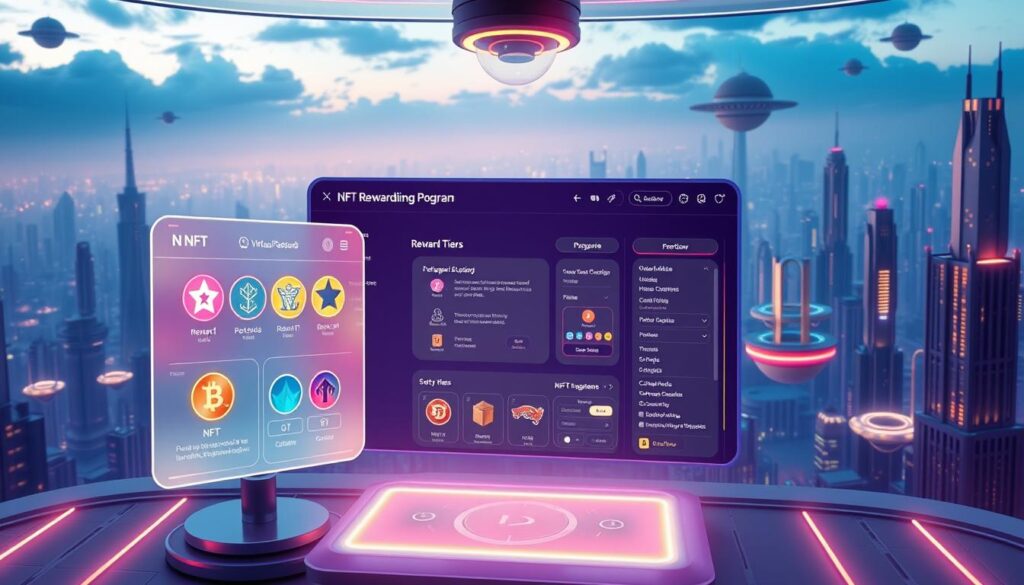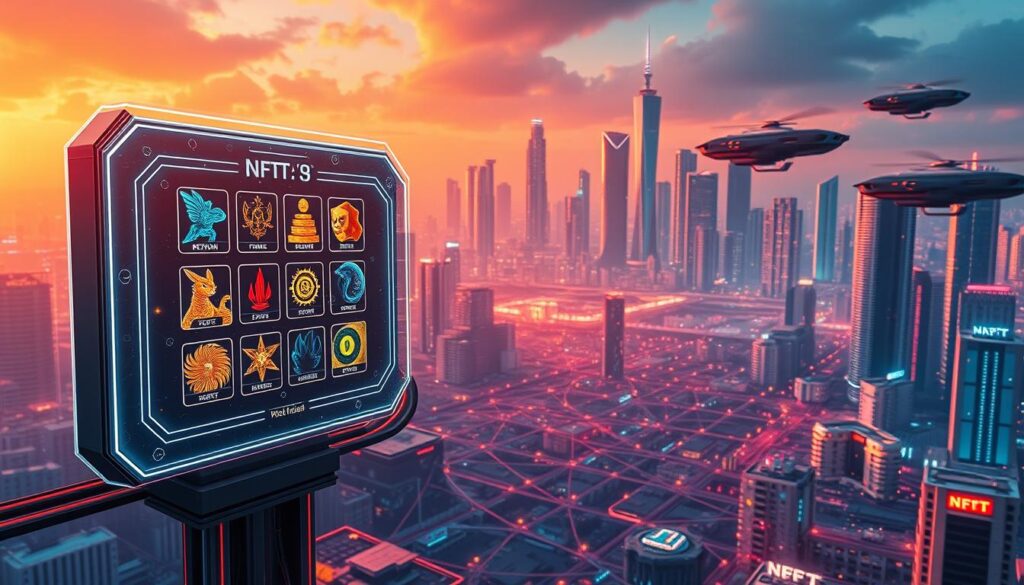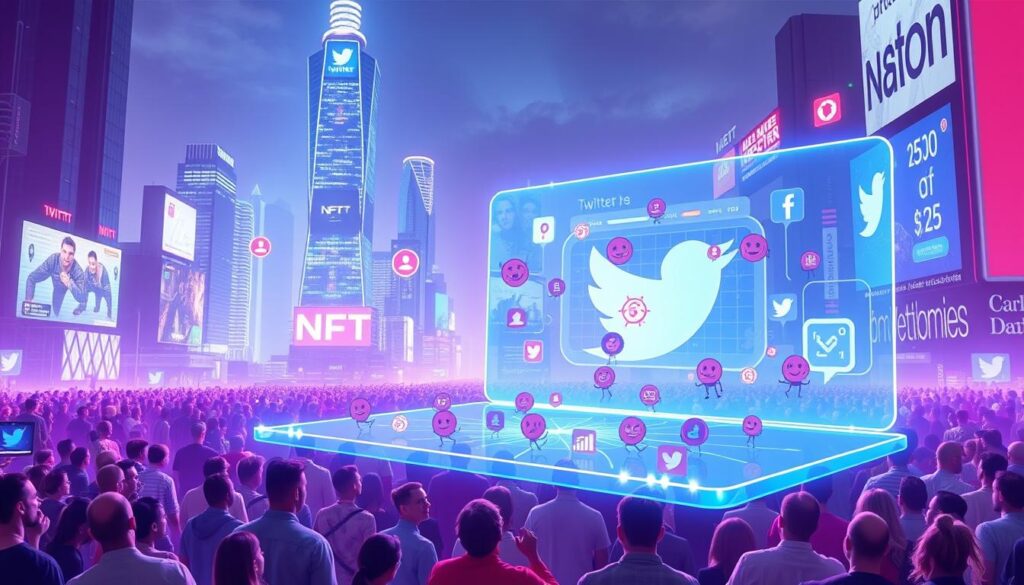Now Reading: Unlock the Secrets of NFT Rewards in Web3
- 01
Unlock the Secrets of NFT Rewards in Web3
Unlock the Secrets of NFT Rewards in Web3

NFT rewards are changing how we see digital rewards. It’s key for businesses and people to know how NFT rewards work in Web3. Learning about NFT rewards might seem hard, but it’s vital to unlock their power. They let creators and brands give back to their fans in special ways.
Exploring NFT rewards, we find many benefits and chances. Understanding NFT rewards in Web3 might seem complex, but it’s simple once you get it. Starting with an introduction, we’ll see the endless possibilities they offer.
Introduction to the World of NFT Rewards
NFT rewards are getting more popular, and knowing how they work in Web3 is key. By learning about NFT rewards, we open up new chances for growth and connection. Whether you’re a creator, brand, or person, knowing about NFT rewards in Web3 can help you use this new tech well.
Key Takeaways
- Understanding how NFT rewards work in Web3 is crucial for businesses and individuals.
- An introduction to NFT rewards can seem daunting, but it’s essential to grasp the concept.
- NFT rewards offer a unique opportunity for creators and brands to reward their communities.
- How NFT rewards work in Web3 is a complex topic, but it can be broken down into simple concepts.
- NFT rewards are becoming increasingly popular, and it’s essential to understand how they work.
Understanding the Fundamentals of NFT Rewards
To understand NFT rewards, we need to explore Web3 and its key technologies. Understanding NFT rewards in Web3 means knowing about blockchain, smart contracts, and cryptocurrency. The Web3 NFT reward system is all about decentralization, transparency, and security. This makes it appealing to both creators and users.
NFTs are special because they show who owns digital items like art or music. This makes them perfect for rewards because they can be checked and moved easily. Web3 helps in making NFT rewards by giving creators a place to manage and share them safely.
Key Characteristics of NFT Rewards
- Unique digital assets
- Verifiable ownership
- Decentralized distribution
- Transparent transaction history
In the world of Understanding NFT rewards in Web3, the Web3 NFT reward system is key. It helps in making, sharing, and managing NFT rewards. With Web3, creators can create unique reward systems. These systems encourage people to get involved, grow communities, and support digital ownership.
The Evolution of Digital Rewards in the Web3 Era
The evolution of digital rewards has seen big changes over time. It has changed how we see and use reward systems. Now, we have NFT rewards in Web3, making things more complex and advanced.
Looking into the history of digital rewards shows important steps and new ideas. The use of NFT rewards mechanism has been key. It lets us make unique, verifiable, and tradable digital items.
Some big changes in digital rewards include:
- The start of digital tokens and coins
- The growth of blockchain technology and its uses
- The rise of NFTs in reward systems
The evolution of digital rewards will keep going, with NFT rewards mechanism being very important. As Web3 grows, we’ll see more new ideas in digital rewards. This will change how we see and use rewards even more.
How NFT Rewards Work in Web3: A Deep Dive
Understanding How NFT rewards work is key to getting around Web3. We’ll look into the tech behind NFT rewards. This includes smart contracts, how rewards are given out, and the types of tokens used.
NFT rewards in Web3 are made possible by Web3 NFT incentives. These incentives set up a system for making and sharing unique digital items. Let’s break down the main parts involved.
Smart Contract Integration
Smart contracts are crucial for How NFT rewards work. They make it possible to automate how rewards are given out. With smart contracts, developers can write contracts that run on their own, with rules set in code.
Reward Distribution Protocols
Reward distribution protocols are key for fair and efficient NFT rewards. They use complex algorithms to figure out who gets what. This depends on how much users engage and contribute.

Token Standards and Compatibility
Token standards and compatibility are vital for NFT rewards to work well. They make sure rewards can be moved and kept easily. Standardized token protocols help create NFT rewards that work with many wallets and platforms.
Benefits of Implementing NFT Reward Systems
The Benefits of NFT rewards are many. Businesses are now using NFT reward systems to make things better for users. They create a feeling of ownership and specialness, which makes customers more loyal and likely to stay.
Some main benefits of NFT rewards are:
- More user involvement and action
- Better customer loyalty and keeping customers
- More unique and special rewards for users
NFT rewards also help encourage good actions, like finishing tasks or hitting goals. This is really helpful in areas like gaming or learning. By using Benefits of NFT rewards, companies can make their customers’ experiences more fun and rewarding.
In summary, the NFT rewards model brings lots of good things for both businesses and users. It leads to more engagement, loyalty, and a better experience for everyone. As NFT rewards become more common, it will be exciting to see how they change different fields and make things better for customers.
Types of NFT Rewards in Web3 Ecosystems
The Web3 ecosystem has many Types of NFT rewards to motivate users and make experiences fun. These rewards are great for loyalty programs, gaming, and social media. By using Web3 non-fungible token rewards, companies can offer unique and valuable experiences.
Some common types of NFT rewards include:
- Achievement-based rewards, which are given to users for completing specific tasks or achieving certain milestones.
- Participation incentives, which encourage users to participate in certain activities or events.
- Loyalty program NFTs, which reward users for their loyalty and continued engagement with a brand or platform.
These NFT rewards can help create many experiences, from simple rewards to complex gaming worlds. By knowing the different NFT rewards, businesses can make engaging strategies. This helps build loyalty and connect with users.
Setting Up Your First NFT Reward Program
When setting up an NFT reward program, think about the technical side and your strategy. You need to pick the right platform, design your NFTs, and plan how to give out NFT rewards. A good program can boost user engagement and loyalty.
To start, choose a blockchain platform and a user-friendly interface. Decide on the NFT types and how to give them out. You could use a random drop, a purchase, or as a reward for achieving certain milestones.
Some important things to consider for setting up an NFT reward program include:
- Defining the program’s goals and objectives
- Choosing the right NFT design and metadata
- Developing a fair and transparent NFT reward distribution system

By planning and executing your NFT reward program well, you can offer a unique and engaging experience. This can help keep users coming back and loyal. Always check how the program is doing and make changes as needed.
Technical Requirements for NFT Reward Implementation
Setting up NFT rewards needs careful thought about several tech aspects. You need a strong blockchain, smart contracts, and an easy-to-use interface. A good NFT reward plan is key for success.
Some important things to think about for NFT rewards include:
- Blockchain infrastructure: A scalable and secure blockchain network is essential for supporting NFT rewards.
- Smart contract development: Smart contracts must be carefully designed and developed to ensure the secure and efficient distribution of NFT rewards.
- User interface considerations: A user-friendly interface is necessary for users to easily interact with the NFT reward system.
Blockchain Infrastructure
A strong blockchain is the base of a good NFT reward system. It must handle lots of transactions and keep NFT rewards safe and sound.
Smart Contract Development
Smart contracts are vital for safe and smooth NFT reward distribution. They need to be well-made and tested to work right.
User Interface Considerations
A user-friendly interface is crucial for easy use of the NFT reward system. It should be simple and offer a smooth experience.
Measuring Success in NFT Reward Programs
To see if NFT rewards work in Web3, we need to set up some key metrics. It’s important to know how NFT rewards work in Web3 to make good programs. By looking at these metrics, we can make better choices for our NFT reward systems.
Important metrics include how engaged users are, how well they stick around, and the value of the rewards. Engagement rates show how many people take part in activities for NFTs. User retention shows how many keep coming back.
When checking if an NFT reward program works, we should also look at a few things:
- Participation rates: How many users join the program
- Reward redemption rates: How many use their NFT rewards
- User satisfaction: How happy users are with the rewards and the program
By watching these metrics and tweaking the program, we can make it better for users. This helps our Web3 apps succeed. Keeping an eye on these metrics is key to making sure our programs meet their goals. Knowing how NFT rewards work in Web3 is crucial for success.
Common Challenges and Solutions in NFT Rewards
Implementing NFT rewards in Web3 comes with several challenges. It’s important to know these challenges to find good solutions. One big issue is managing gas fees, which can be very expensive. How NFT rewards work in Web3 also matters a lot, as it affects how users feel and how well the system works.
Some major problems with NFT reward programs include:
- Gas fee management: High fees can make transactions pricey and slow.
- Scalability issues: As more users join, the system needs to stay fast and efficient.
- User adoption barriers: If things are too complicated, people might not want to join.
To tackle these problems, we need to come up with smart strategies. For example, we can make smart contracts more efficient and use layer 2 solutions to scale better. We also need to make things easier to understand and use. This way, more people can enjoy NFT rewards in Web3.
Best Practices for NFT Reward Distribution
Understanding NFT rewards explanation is key. A good system makes sure everything is fair, clear, and safe. Studies show that a clear rewards program is vital.
Here are some important points to keep in mind:
- Make sure the reward structure is clear and open
- Use secure ways to give out rewards
- Keep participants well-informed
By following these tips, creators can make a great NFT reward system. This system will help keep people interested and loyal.
A well-made NFT reward system is crucial for any Web3 project. It boosts participation and excitement. By focusing on fairness and best practices, creators can gain their community’s trust. This is key for the project’s long-term success.
Security Considerations for NFT Reward Systems
When setting up a Web3 NFT reward system, security considerations are key. They ensure the system is safe and trustworthy. A good system protects users’ assets and keeps the ecosystem healthy. Research shows we need a strong security plan for NFT rewards.
Securing NFT reward systems starts with smart contract auditing. This means checking and testing the smart contracts that run the system. It helps find and fix problems that bad actors could use. Also, strong wallet security measures are vital to keep users’ assets safe and prevent unauthorized access.
- Regular security audits and penetration testing
- Implementing anti-fraud mechanisms, such as multi-factor authentication and rate limiting
- Utilizing secure and reputable wallet solutions
By focusing on security and using strong measures, Web3 NFT reward systems can offer a safe place for users. This lets them enjoy and benefit from the system without worry.
Real-World Applications and Success Stories
NFT rewards have grown a lot in different fields, showing many success stories. Companies use NFT rewards to get customers to engage more, stay loyal, and join in. This has worked well for them.
In the gaming world, players get special digital items for reaching goals or joining events. This has made players more involved and loyal, proving NFT rewards can work well.
Marketing campaigns also use NFT rewards. Companies give unique digital items to customers who take part in promotions or tell friends. This boosts brand fame and keeps customers coming back, showing NFT rewards are good for business.

These stories show NFT rewards can be used in many ways, like in gaming, marketing, education, and social media. As NFT tech gets better, we’ll see even more creative uses of NFT rewards.
Using NFT rewards can bring many benefits. It can increase customer engagement, boost loyalty, and raise brand awareness. Companies can make their rewards systems more interesting and effective, leading to better business results and happier customers.
Integration Strategies with Existing Platforms
Integrating Web3 NFT incentives with existing platforms is key for a smooth user experience. Good integration strategies are vital for the success of NFT reward programs. By using the right strategies, businesses can fully benefit from Web3 NFT incentives and engage their users better.
Businesses can focus on API implementation to integrate NFT rewards with current systems. They can create custom APIs or use existing ones, based on their needs. Also, cross-platform compatibility is crucial to let users access NFT rewards on various platforms and devices.
Important considerations for integration strategies include:
- Building a strong API infrastructure for NFT reward programs
- Making sure NFT rewards work on different platforms
- Improving user experience with easy-to-use interfaces and smooth navigation
By focusing on these areas, businesses can offer a unified and engaging experience. This will help their Web3 NFT incentive programs succeed. Adopting the right integration strategies lets businesses lead the way in the growing Web3 NFT incentives market.
Shaping the Future of Digital Incentives Through NFT Rewards
The world of Web3 is growing fast, and NFT rewards are leading the way in digital incentives. These unique digital assets make experiences more engaging and rewarding. They promise to change how we interact with digital platforms, making every interaction memorable and valuable.
We’re on the verge of seeing more NFT rewards in action. More companies will use them to keep users loyal, improve brand experiences, and find new ways to make money. Thanks to blockchain, NFT rewards are secure, transparent, and flexible, setting the stage for the next big thing in digital incentives.
NFT rewards are set to play a key role in the future of digital incentives. They offer users something real, unique, and tradable. This could change how we view engagement, loyalty, and the value of digital interactions. The future looks bright for those who use NFT rewards to create new and exciting experiences for their audiences.
FAQ
What are NFT rewards in Web3?
NFT rewards in Web3 are digital items you can earn and trade. They are unique and prove you own something special. This can be art, collectibles, or even in-game items.
How do NFT rewards work in Web3?
NFT rewards use smart contracts to manage them. These contracts set rules for earning and using the rewards. You get them by doing tasks or showing you care about the platform.
What are the benefits of implementing NFT reward systems?
NFT rewards boost user interest and loyalty. They also help brands stand out and create new ways to make money. This is through trading and owning unique digital items.
What are the different types of NFT rewards in Web3 ecosystems?
There are many types of NFT rewards. You can get them for achieving goals, participating in activities, or being loyal to a platform.
What are the technical requirements for implementing NFT rewards?
To start NFT rewards, you need a strong blockchain and smart contracts. You also need a user-friendly way to manage and trade these rewards.
How can I measure the success of an NFT reward program?
Success can be measured by looking at user activity, sales, and how the program grows the ecosystem. By tracking these, you can make your program better.
What are the common challenges in implementing NFT reward systems?
Challenges include managing costs, scaling, and getting users to join. Solutions include smart cost management, scalable tech, and educating users.
What are the best practices for distributing NFT rewards?
For fair and secure rewards, use lottery systems and be clear about the program. Make sure it’s safe from fraud and easy to understand.
How can I integrate NFT rewards with existing platforms?
To add NFT rewards, use APIs and ensure they work well with other platforms. Make sure the experience is smooth and natural for users.














